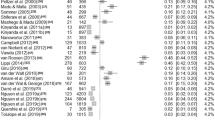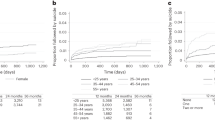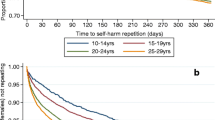Abstract
The repetition of hospital-treated self-harm by young people is common. However, little work has summarised the modifiable factors associated with this. A thorough understanding of those factors most strongly associated with repetition could guide the development of relevant clinical interventions. We systematically reviewed four databases (EMBASE, Medline, PubMed and PsycINFO) until 15 April 2016 to identify all observational studies of factors for the repetition of self-harm or suicide reattempts (together referred to as ‘self-harm behaviour’) in young people. We quantified the magnitude of association with odds ratios (OR) and 95% confidence intervals (CIs) and calculated the population attributable risk (PAR) and population preventable fraction (PPF) for modifiable factors to provide an indication of the potential impact in reducing subsequent self-harm behaviour in this population. Seventeen studies were included comprising 10,726 participants. Borderline personality disorder (OR 3.47, 95% CI 1.84–6.53; PAR 42.4%), any personality disorder (OR 2.54, 95% CI 1.71–3.78; PAR 16.3%), and any mood disorder (OR 2.16, 95% CI 1.09–4.29; PAR 42.2%) are important modifiable risk factors. Severity of hopelessness (OR 2.95, 95% CI 1.74–5.01), suicidal ideation (OR 2.01, 95% CI 1.43–2.81), and previous sexual abuse (OR 1.52, 95% CI 1.02–2.28; PAR 12.8%) are also associated with repetition of self-harm. We recommend that clinical services should focus on identifying key modifiable risk factors at the individual patient level, whilst the reduction of exposure to child and adolescent sexual abuse would also be a useful goal for public health interventions.

From: [25]. For more information, visit http://www.prisma-statement.org
Similar content being viewed by others
References
Hawton K, Harriss L, Hall S, Simkin S, Bale E, Bond A (2003) Deliberate self-harm in Oxford, 1990–2000: a time of change in patient characteristics. Psychol Med 33:987–995
Hawton K, Witt K, Taylor Salisbury T, Arensman E, Gunnell D, Hazell P, Townsend E, van Heeringen K (2016) Psychosocial interventions for self-harm in adults. Cochrane Database Syst Rev 5:CD012189
Hawton K, Saunders KEA, O’Connor RC (2012) Self-harm and suicide in adolescents. Lancet 379:2373–2382
Australian Institute of Health and Welfare (2013) Trends in hospitalised injury, Australia, 1999–00 to 2010–11. Injury Research and Statistics Series, number 86. Australian Institute of Health and Welfare, Canberra, ACT
Hawton K, Fagg J, Simkin S, Bale E, Bond A (2000) Deliberate self-harm in adolescents in Oxford, 1985–1995. J Adolesc 23:47–55
Hawton K, Rodham K, Evans E, Weatherall R (2002) Deliberate self harm in adolescents: self report survey in schools in England. BMJ 325:1207–1211
McMahon E, Keeley H, Cannon M, Arensman E, Perry I, Clarke M, Chambers D, Corcoran P (2014) The iceberg of suicide and self-harm in Irish adolescents: a population-based study. Soc Psychiatr Psychiatric Epidemiol 49:1929–1935
Ystgaard M, Arensman E, Hawton K, Madge N, Van Heeringen K, Hewitt A, De Wilde E, De Leo D, Fekete S (2009) Deliberate self-harm in adolescents: comparison between those who receive help following self-harm and those who do not. J Adolesc 32:875–891
Evans E, Hawton K, Rodham K, Deeks J (2005) The prevalence of suicidal phenomena in adolescents: a systematic review of population-based studies. Suicide Life Threat Behav 35:239–250
Owens D, Horrocks J, House A (2002) Fatal and non-fatal repetition of self-harm. A systematic review. Br J Psychiatry 181:193–199
Hawton K, Bergen H, Kapur N, Cooper J, Steeg S, Ness J, Waters K (2012) Repetition of self-harm and suicide following self-harm in children and adolescents: findings from the Multicentre Study of Self-Harm in England. J Child Psychol Psychiatry 53:1212–1219
Madge N, Hewitt A, Hawton K, Wilde EJD, Corcoran P, Fekete S, van Heeringen K, De Leo D, Ystgaard M (2008) Deliberate self-harm within an international community sample of young people: comparative findings from the Child and Adolescent Self-harm in Europe (CASE) Study. J Child Psychol Psychiatry 49(6):667–677
World Health Organisation (2014) Preventing Suicide: a global imperative. World Health Organisation, Geneva
National Institute for Health and Care Excellence (2004) Self-harm: the short-term physical and psychological management and secondary prevention of self-harm in primary and secondary care. National Instutute of Clinical Excellence, London
National Institute for Health and Care Excellence (2011) Self-harm: longer term management. National Collaborating Centre for Mental Health and the British Psychological Society, Leiceser
Royal College of Psychiatrists (2010) Self-harm, Suicide and Risk: Helping People who Self-Harm [college report: CR158]. Royal College of Psychiatrists, London
Carter G, Page A, Large M, Hetrick S, Milner A, Bendit N, Walton C, Draper B, Hazell P, Fortune S, Burns J, Patton G, Lawrence M, Dadd L, Robinson J, Christensen H (2016) Royal Australian and New Zealand College of Psychiatrists clinical practice guideline for the management of deliberate self-harm. Aust N Z J Psychiatry 50:939–1000
Carroll R, Metcalfe C, Steeg S, Davies N, Cooper J, Kapur N, Gunnell D (2016) Psychosocial assessment of self-harm patients and risk of repeat presentation: an instrumental variable analysis using time of hospital presentation. PLoS ONE 11:e0149713
Bergen H, Hawton K, Waters K, Cooper J, Kapur N (2010) Psychosocial assessment and repetition of self-harm: the significance of single and multiple repeat episode analyses. J Affect Disord 127:257–265
Robinson J (2016) Repeated self harm in young people: a review. Aust Psychiatry 25:105–107
Hawton K, Bergen H, Waters K, Ness J, Cooper J, Steeg S, Kapur N (2012) Epidemiology and nature of self-harm in children and adolescents: findings from the Multicentre Study of Self-Harm in England. Eur Child Adolesc Psychiatry 21:369–377
Madge N, Hawton K, McMahon E, Corcoran P, De Leo D, De Wilde E, Fekete S, Van Heeringen K, Ystgaard M, Arensman E (2011) Psychological characteristics, stressful life events and deliberate self-harm: findings from the Child and Adolescent Self-Harm in Europe (CASE) study. Eur Child Adolesc Psychiatry 20:499–508
Hinduja S, Patchin J (2010) Bullying, cyberbullying, and suicide. Arch Suic Res 14:206–221
Kessler R, Berglund P, Demler O, Jin R, Merikangas K, Walters E (2005) Lifetime prevalence and age-of-onset distributions of DSM-IV disorders in the national comorbidity survey replication. Arch Gen Psychiatry 62:593–602
Moher D, Liberati A, Tetzlaff J, Altman D (2009) Preferred reporting items for systematic reviews and meta-analyses: the PRISMA statement. PLoS ONE 6:e1000097
Carroll R, Metcalfe C, Gunnell D (2014) Hospital presenting self-harm and risk of fatal and non-fatal repetition: systematic review and meta-analysis. PLoS ONE 9(2):e89944
Bürk F, Möller H (1985) Prädiktoren für weiteres suizidales Verhalten bei nach einem Suizidversuch hospitalisierten Patienten [Predictors of further suicidal behavior in hospitalized patients following a suicide attempt: literature review]. Fortschr Neurol Psychiatr 53:259–270
Beghi M, Rosenbaum J, Cerri C, Cornaggia C (2013) Risk factors for fatal and non-fatal repetition of suicide attempts: a literature review. Neuropsychiatr Dis Treat 9:1725–1736
Fliege H, Lee J, Grimm A, Klapp B (2009) Risk factors and correlates of deliberate self-harm behavior: a systematic review. J Psychosom Res 66:477–493
Fox K, Franklin J, Ribeiro J, Kleiman E, Bentley K, Nock M (2015) Meta-analysis of risk factors for nonsuicidal self-injury. Clin Psychol Rev 42:156–167
Myers E (1988) Predicting repetition of deliberate self-harm: a review of the literature in the light of a current study. Acta Psychiatr Scand 77:314–319
Bhui K, McKenzie K, Rasul F (2007) Rates, risk factors, and methods of self harm among minority ethnic groups in the UK: a systematic review. BMC Public Health 7:336
Larkin C, Di Blasi Z, Arensman E (2014) Risk factors for repetition of self-harm: a systematic review of prospective hospital-based studies. PLoS ONE 9(1):e84282
Krawczyk J, Gmitrowicz A (2014) Analysis of the factors protecting against suicide. Psychiatria i Psychologia Kliniczna 14(1):43–49
McMillian D, Gilbody S, Beresford E, Neilly L (2007) Can we predict suicide and non-fatal self-harm with the Beck Hopelessness Scale? A meta-analysis. Psychol Med 37:769–778
Pires M, Silva T, Passos M, Sougey E, Bastos Filho O (2014) Risk factors of suicide attempts by poisoning: review. Trends Psychiatry Psychother 36:63–74
Deeks J, Higgins J, Altman D (2011) Analysing data and undertaking meta-analyses. In: Higgins J, Green S (eds) Cochrane handbook of systematic reviews of interventions. The Cochrane Collaboration, London
DerSimonian R, Laird N (1986) Meta-analysis in clinical trials. Control Clin Trials 7:177–188
Higgins J, Thompson S, Deeks J, Altman D (2003) Measuring inconsistency in meta-analyses. BMJ 327:557
Li Z, Page A, Martin G, Taylor R (2011) Attributable risk of psychiatric and socio-economic factors for suicide from individual-level, population-based studies: a systematic review. Soc Sci Med 72:608–616
Shield K, Parkin D, Whiteman D, Rehm J, Viallon V, Micallef C, Vineis P, Rushton L, Bray F, Soerjomataram I (2016) Population attributable and preventable fractions: cancer risk factor surveillance, and cancer policy projection. Curr Epidemiol Rep 3:201–211
BioStat (2014) Comprehensive Meta-Analysis (version 3.3.070). Biostat Corporation, Englewood, NJ
National Heart Lung and Blood Institute (2014) Quality assessment tool for observational cohort and cross-sectional studies. http://www.nhlbi.nih.gov/health-pro/guidelines/in-develop/cardiovascular-risk-reduction/tools/cohort. Accessed 1 Apr 2016
Burns C, Cortell R, Wagner B (2008) Treatment compliance in adolescents after attempted suicide: a two-year follow-up study. J Am Acad Child Adolesc Psychiatry 47:948–957
Czyz E, Berona J, King C (2015) A prospective examination of the interpersonal-psychological theory of suicidal behavior among psychiatric adolescent inpatients. Suic Life Threat Behav 45:243–259
Barter J, Swaback D, Todd D (1968) Adolescent suicide attempts: a follow-up study of hospitalized patients. Arch Gen Psychiatry 19:523–527
Spirito A, Lewander W, Levy S, Kurkjian J, Fritz G (1994) Emergency department assessment of adolescent suicide attempters: factors related to short-term follow-up outcome. Psychiatr Emerg Care 10:6–12
Chitsabesan P, Harrington R, Harrington V, Tomenson B (2003) Predicting repeat self-harm in children: how accurate can we expect to be? Eur Child Adolesc Psychiatry 12:23–29
Glazebrook K, Townsend E, Sayal K (2015) The role of attachment style in predicting repetition of adolescent self-harm: a longitudinal study. Suic Life Threat Behav 45:664–678
Hawton K, Harriss L (2008) Deliberate self-harm by under-15-year-olds: characteristics, trends and outcome. J Child Psychol Psychiatry 49:411–418
Hawton K, Kingsbury S, Stwinhardt K, James A, Fagg J (1999) Repetition of deliberate self-harm by adolescents: the role of psychological factors. J Adolesc 22:369–378
Vajda J, Steinbeck K (2000) Factors associated with repeat suicide attempts among adolescents. Aust N Z J Psychiatry 34:437–445
Reith D, Whyte I, Carter G (2003) Repetition risk for adolescent self-poisoning: a multiple event survival analysis. Aust N Z J Psychiatry 37:212–218
Hu N, Glauert R, Li J, Taylor C (2016) Risk factors for repetition of a deliberate self-harm episode within seven days in adolescents and young adults: a population-level record linkage study in Western Australia. Aust N Z J Psychiatry 50:154–166
Hultén A, Jiang G-X, Wasserman D, Hawton K, Hjelmeland H, De Leo D, Ostamo A, Salander Renberg E, Schmidtke A (2001) Repetition of attempted suicide among teenagers in Europe: frequency, timing and risk factors. Eur Child Adolesc Psychiatry 10:161–169
Consoli A, Cohen D, Bodeau N, Guilé J-M, Mirkovic B, Knafo A, Mahé V, Laurent C, Renaud J, Labelle R, Breton J-J, Gérardin P (2015) Risk and protective factors for suicidality at 6-month follow-up in adolescent inpatients who attempted suicide: an exploratory model. Can J Psychiatry 60:s27–s36
Groholt B, Ekeberg Ø, Haldorsen T (2006) Adolescent suicide attempters: what predicts future suicidal acts? Suic Life Threat Behav 36:638–650
Méan M, Righini N, Narring F, Jeannin A, Michaud P-A (2005) Substance use and suicidal conduct: a study of adolescents hospitalized for suicide attempt and ideation. Acta Paediatr 94:952–959
Selby E, Yen S, Spirito A (2013) Time varying prediction of thoughts of death and suicidal ideation in adolescents: weekly rating over 6-month follow-up. J Clin Child Adolesc Psychol 42:481–495
Yen S, Weinstock L, Andover M, Sheets E, Selby E, Spirito A (2013) Prospective predictors of adolescent suicidality: 6-month post-hospitalization follow-up. Psychol Med 43:983–993
Moran P, Coffey C, Romaniuk H, Olsson C, Borschmann R, Carlin J, Patton G (2012) The natural history of self-harm from adolescence to young adulthood: a population-based cohort study. Lancet 379:236–243
McDermott B, Baigent M, Chanen A, Fraser L, Graetz B, Hayman N, Newman L, Parikh N, Peirce B, Proimos J, Smalley T, Spence S (2010) Clinical practice guidelines: depression in adolescents and young adults. Beyondblue: The National Depression Initiative, Melbourne
Malhi G, Bassett D, Boyce P, Bryant R, Fitzgerald P, Fritz K, Hopwood M, Lyndon B, Mulder R, Murray G, Porter R, Singh A (2015) Royal Australian and New Zealand College of Psychiatrists clinical practice guidelines for mood disorders. Aust N Z J Psychiatry 49:1–185
National Institute for Health and Care Excellence (2005) Depression in children and young people: identification and management in primary, community and secondary care [Clinical Practice Guidelines, no. 28]. British Psychological Society, Leicester
Birmaher B, Brent D (2007) Practice parameter for the assessment and treatment of children and adolescents with depressive disorders. J Am Acad Child Adolesc Psychiatry 46:1503–1526
Sharp C, Green K, Yaroslavsky I, Venta A, Zanarini M, Pettit J (2012) The incremental validity of borderline personality disorder relative to major depressive disorder for suicidal ideation and deliberate self-harm in adolescents. J Pers Disord 26:927–938
Hawton K, Witt K, Taylor Salisbury T, Arensman E, Gunnell D, Townsend E, van Heeringen K, Hazell P (2015) Interventions for self-harm in children and adolescents. Cochrane Database Syst Rev 12:CD012013
Ougrin D, Tranah T, Stahl D, Moran P, Asarnow J (2015) Therapeutic interventions for suicide attempts and self-harm in adolescents: systematic review and meta-analysis. J Am Acad Child Adolesc Psychiatry 54:97–107
Hetrick S, Robinson J, Spittal M, Carter G (2016) Effective psychological and psychosocial approaches to reduce repetition of self-harm: a systematic review, meta-analysis and meta-regression. BMJ Open 6:e011024
Barth J, Bermetz L, Heim E, Trelle S, Tonia T (2013) The current prevalence of child sexual abuse worldwide: a systematic review and meta-analysis. Int J Public Health 58:469–483
Walsh K, Zwi K, Woolfenden S, Shlonsky A (2015) School-based education programmes for the prevention of child sexual abuse. Cochrane Database Syst Rev 4:CD004380
Barron I, Miller D, Kelly T (2015) School-based child sexual abuse prevention programs: moving toward resiliency-informed evaluation. J Child Sexual Abuse 24:77–96
Topping K, Barron I (2009) School-based child sexual abuse prevention programs: a review of effectiveness. Rev Educat Res 79:431–463
Rudolph J, Zimmer-Gembeck M (2016) Reviewing the focus: A summary and critique of child-focused sexual abuse prevention. Trauma Violence Abuse. https://doi.org/10.1177/1524838016675478
Christiansen E, Agerbo E, Larsen K, Bilenberg N, Stenager E (2015) Youth, suicide attempts and low level of education: a Danish historical register-based cohort study of the outcome of suicide attempt. Int J Soc Psychiatry 61:802–810
Langille D, Asbridge M, Cragg A, Rasic D (2015) Associations of school connectedness with adolescent suicidality: gender differences and the role of risk of depression. Can J Psychiatry 60:258–267
Chan J, Draper B, Banerjee S (2007) Deliberate self-harm in older adults: a review of the literature from 1995 to 2004. Int J Geriatr Psychiatry 22(8):720–732
Murphy E, Kapur N, Webb R, Purandare N, Hawton K, Bergen H, Waters K, Cooper J (2012) Risk factors for repetition and suicide following self-harm in older adults: multicentre cohort study. Br J Psychiatry 200:399–404
Czyz E, King C (2015) Longitudinal trajectories of suicidal ideation and subsequent suicide attempts among adolescent inpatients. J Clin Child Adolesc Psychol 44:181–193
Groholt B, Ekeberg Ø (2009) Prognosis after adolescent suicide attempt: mental health, psychiatric treatment, and suicide attempts in a nine-year follow-up study. Suic Life Threat Behav 39:125–136
Ghaziuddin N, Merchant C, Dopp R, King C (2014) A naturalistic study of suicidal adolescents treated with an SSRI: Suicidal ideation and behavior during 3-month post-hospitalization period. Asian J Psychiatry 11:13–19
King CA, Kerr DCR, Passarelli MN, Foster CE, Merchant CR (2010) One-year follow-up of suicidal adolescents: Parental history of mental health problems and time to post-hospitalization attempt. J Youth Adolescence 39:219–232
Glazebrook K, Townsend E, Sayal K (2014) The role of attachment style in predicting repetition of adolescent self-harm: a longitudinal study. Suicide Life Threat Behav 45:664–678
Acknowledgements
The authors gratefully acknowledge the help received by a research assistant, Humaria Maheen, in assisting with ancestry searching.
Author information
Authors and Affiliations
Corresponding author
Ethics declarations
Conflict of interest
The authors have no conflict of interest to declare.
Ethics approval statement
Ethical approval and participant consent were not required for this review, since the study involved review and analysis of previously published data.
Role of the funding source
This work was supported by the Victorian Department of Health and Human Services (DHHS) (Reference number: C4892). Individual authors would also like to acknowledge the following sources of funding: KW is funded by an American Foundation for Suicide Prevention Post-Doctoral Fellowship (Reference number: PDF-0-145-16), SH is funded by an Auckland Medical Research Foundation Douglas Goodfellow Repatriation Fellowship, JR is funded by an NHMRC Early Career Fellowship, and JP is funded by an NHMRC Senior Research Fellowship. Funders had no role in study design, data collection, data analysis, data interpretation, or writing of the manuscript.
Electronic supplementary material
Below is the link to the electronic supplementary material.
Rights and permissions
About this article
Cite this article
Witt, K., Milner, A., Spittal, M.J. et al. Population attributable risk of factors associated with the repetition of self-harm behaviour in young people presenting to clinical services: a systematic review and meta-analysis. Eur Child Adolesc Psychiatry 28, 5–18 (2019). https://doi.org/10.1007/s00787-018-1111-6
Received:
Accepted:
Published:
Issue Date:
DOI: https://doi.org/10.1007/s00787-018-1111-6




